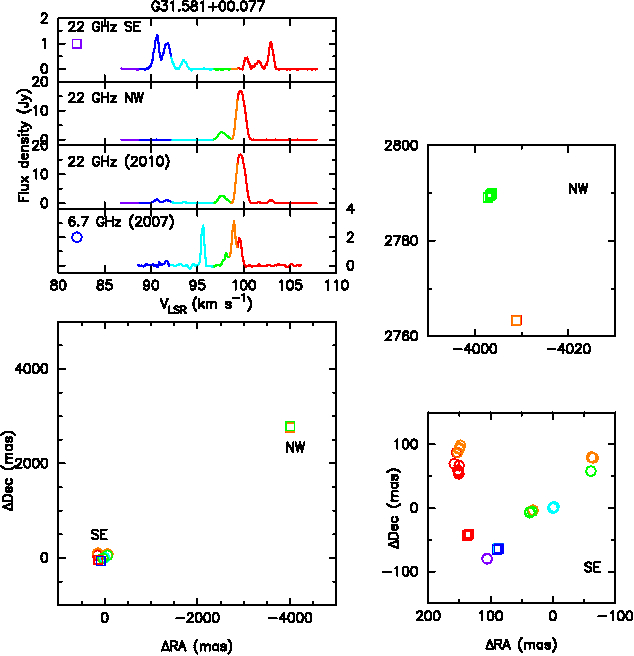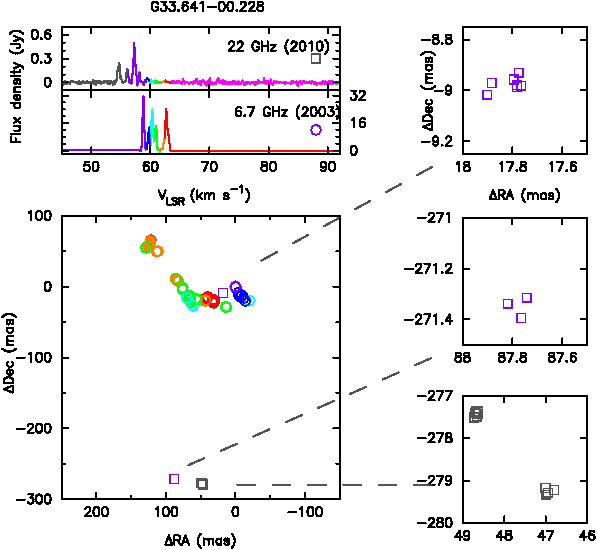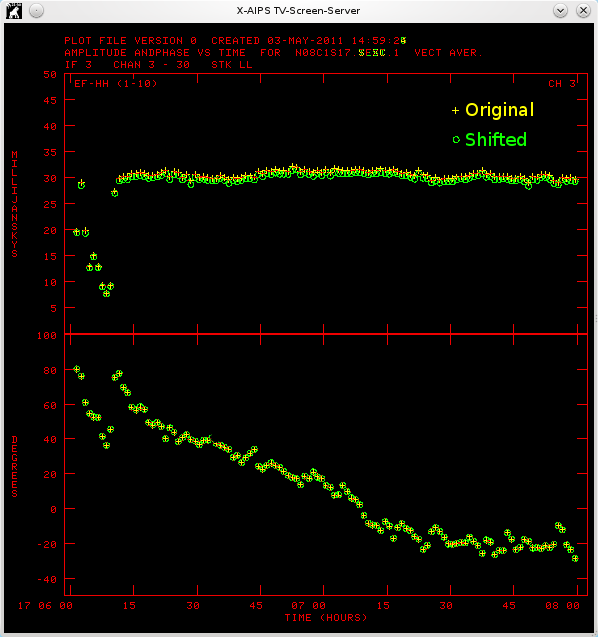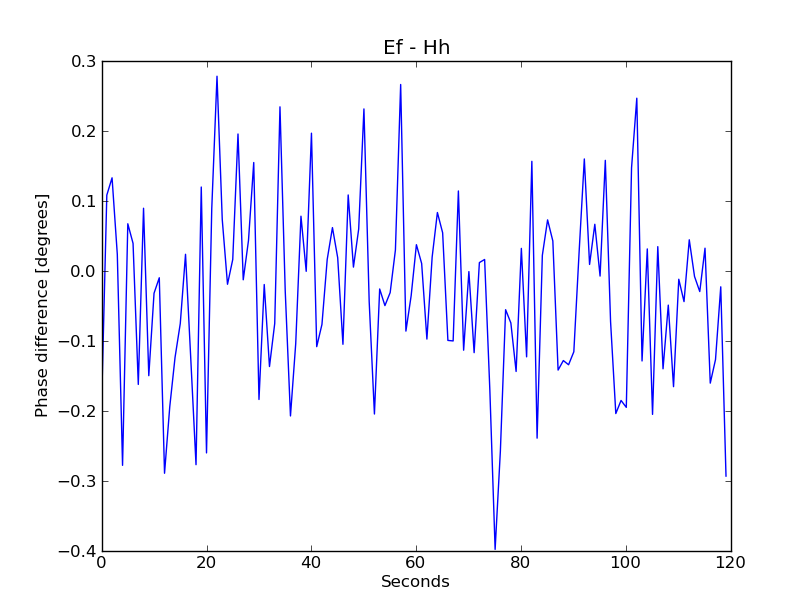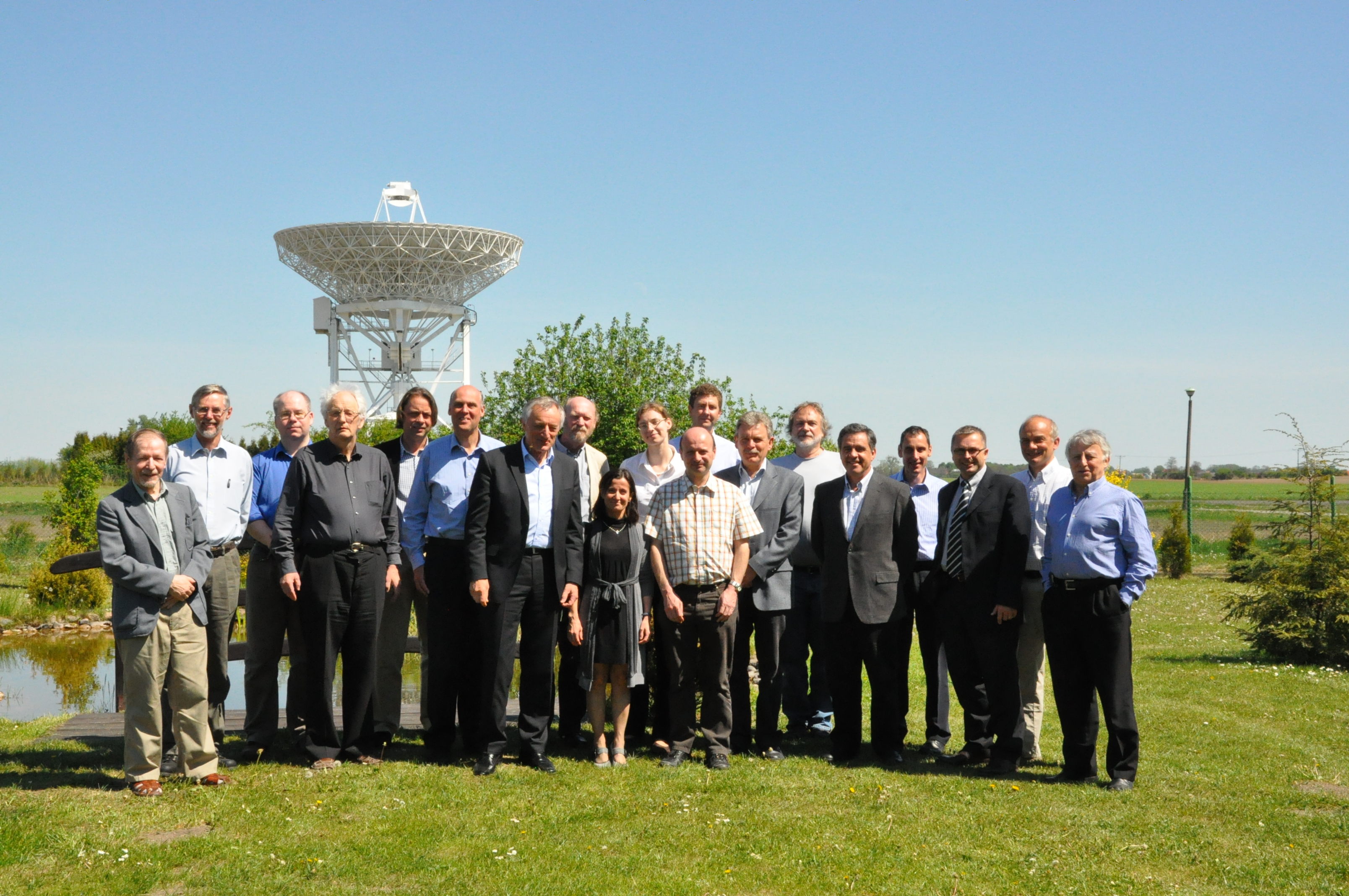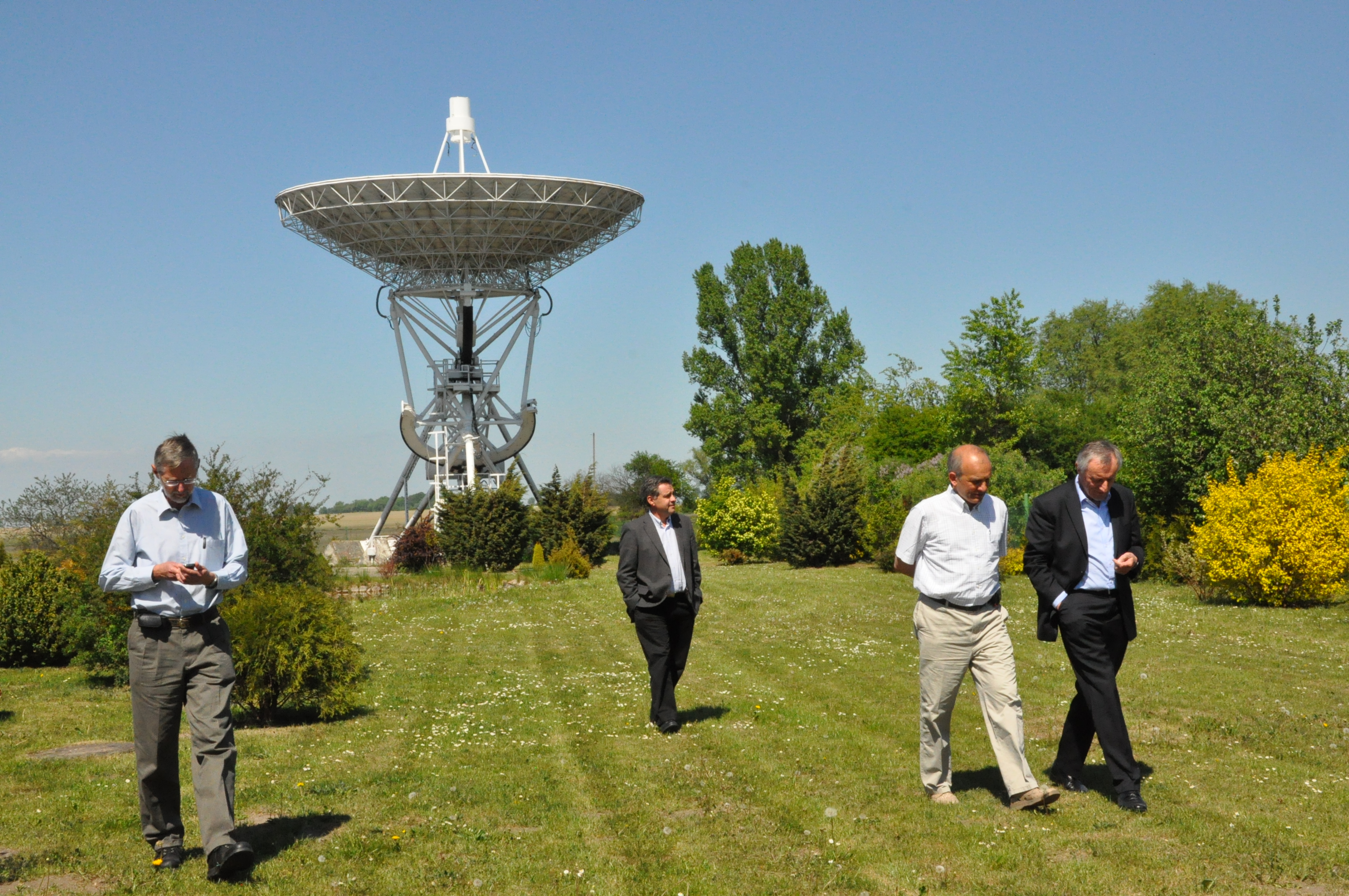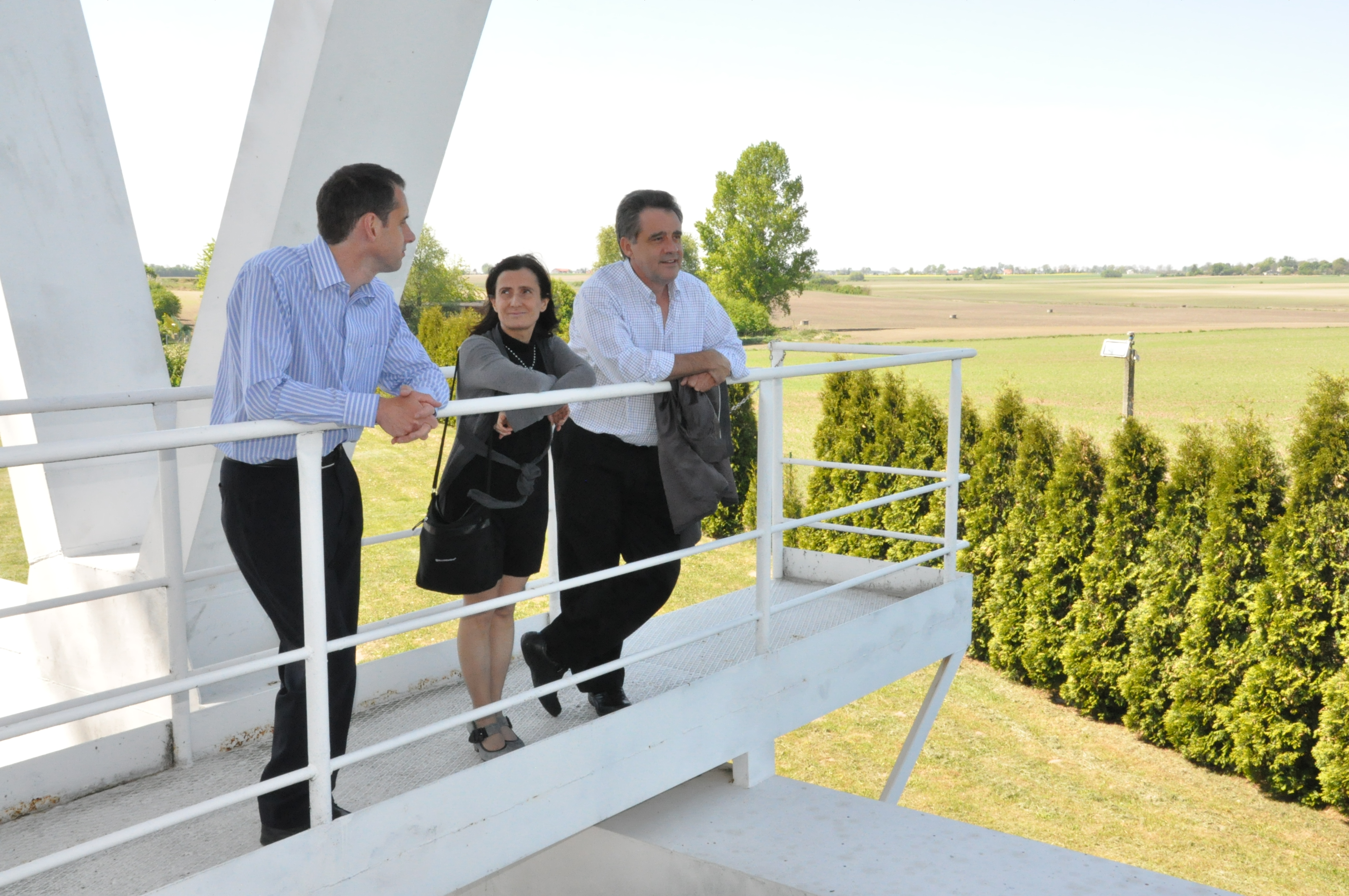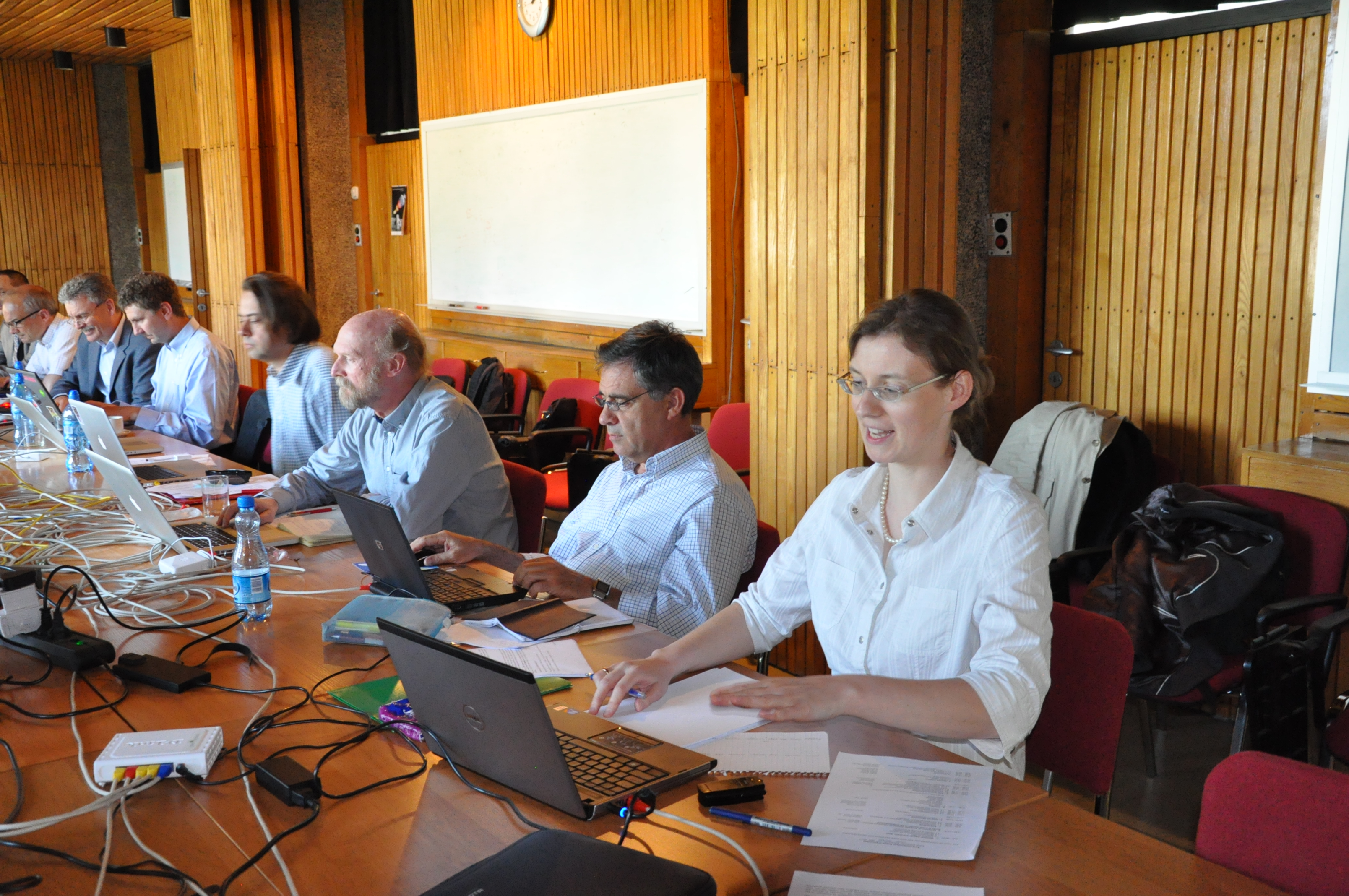|
|
European
VLBI Network Newsletter Number
29 May 2011 |
|
Contents
|
|
1.
Message from the
EVN Chairman 2.
Call for EVN
Proposals - Deadline June 1st 2011 4.
EVN technical
development and operations: |
|
|
1. Message
from the EVN Chairman
Dear Readers,
This latest EVN Newsletter provides you with the updates on EVN activities,
its technological development and on some of the most interesting scientific
results.
As usual I'd like to start with the information on outcomes of recent EVN
Board of Directors Meeting which was held at Torun, Poland. All the EVN
services function normally, and we confirmed sustainable progress in Network
operation, the technical development , improved reliability, and high
quality of scientific results. Thus the European VLBI Network seems to be
at good condition however, the future funds for VLBI may not look so good,
especially when ALMA starts and SKA project begins. The VLBA has already
encountered problem to get sufficient NSF support, yet for the next 5 years
the NRAO with external support help managed to secure the Array operation.
At the same time the European VLBI Network is growing in number of available
telescopes, total collecting surface, broad band receivers and back-ends,
fast speed real time connectivity. With the IAA as a new member with three
32m KVAZAR antennas and soon (within a year) availability of the 70m in
Ussurisk, and recent restart of the 26m at Hartebeesthek Observatory, the
EVN reinforced its power. Over last few years the status of the EVN has
changed significantly. The new stations are aspiring towards the EVN
membership or the allied co-operation. One of them the Simeiz CrRO with 22m
antenna has a long and fruitful history in VLBI, currently being well
equipped and partner in IVS, declares full commitment to EVN. The Simeiz
contribution will be particularly valuable at high frequency bands. The
decision on Simeiz accession has been shifted to the next CBD meeting as
there were not yet direct successful observations made with EVN. The 32m
Venspils antenna (Latvia) should finally start its lengthy prepared service
in VLBI, the Japanese telescopes consider formal engagement to EVN. There
are new large Chinese antennas coming soon into operation, and the 70m
Evpatoria (Ukraine) telescope considers VLBI participation, all the above
present great challenge to the EVN.
Many EVN telescopes are already connected via fiber-optical dedicated cables
allowing more e-EVN experiments and science sessions with 1 Gbps
transmission rate obtained routinely. Recent (March 9-12) record of 65
hours of continuous operation with 10 stations showed the strength of
European real time VLBI.
The JIVE correlators are fully operational and cope with the sessions data
very efficient way. The coordination of e-EVN and fast data release to the
PIs make JIVE a very strong and fundamentally important Institute. The work
to change the status to ERIC is on the way. It may secure EC funds to
support present and future development. It is in the interest of all the
Network Observatories.
ToO procedures were discussed and steps were taken to put high priority at
the stations (responsibility of Directors) and to ease proposal.s submission
process.
Prof. Mike Gaylard the new Director of HartRAO presented detailed
information of MeerKAT and possible connection to the EVN. He also described
potentials of African VLBI Network based on existing communication antennas
located on the continent. This ambitious project has initially started with
the support by HartRAO team to Ghana to install VLBI instrumentation on 32m
antenna in Kuntunse near Accra.
In conclusion, it is clear, that with Arecibo included, the EVN is
truly Global Network with the bright future. At the moment it is the most
advanced and the largest Radio Astronomy instrument in the world. Its
leading position on Northern hemisphere will remain strong also after the
SKA completion. The high resolution images and high precision astrometry
makes the science based on EVN results the forefront astronomical research.
The current EVN chairship concluded the two year activity. The CBD has
elected new Chairman . Prof. Simon Garrington (JBAC, Manchester) and Vice
Chairman - Prof. Anton Zensus, (MPIfR, Bonn). There are changes in
chairpersons of EVN Program Committee - the new Chairman is Dr. Tom Muxlow
(JBAC), and EVN Technical and Operations Group, with the new Chairman Dr.
Michael Lindqvist (OSO, Onsala). My congratulations and best wishes.
Special thanks and congratulations for the excellent work done for the EVN
community are forwarded to Tiziana Venturi. She chaired the PC for many
years and at the same time being very active in science and chairing the
Science Working Group of EC RadioNet FP7, all for the benefits of EVN users
and young scientists.
Similar thanks are also directed to Walter Alef. He was the TOG Chair from
January 2003 leading the technical development of EVN. Shortly summing up,
from tapes and MkIII to MkIV and finally MKV with disk recordings and
implementation of DBBC and finally to e-VLBI. TOG under his dedicated and
professional leadership helped us through nearly all important technical
developments to the high quality technology sustainable, leading
interferometry Network.
I am much obliged to Magdalena Kunert-Bajraszewska the secretary of EVN
Consortium Board, who did a lot of work related to CBD meetings, the EVN
Newsletters, and made various co-ordinations required to proceed smoothly
with CBD activities.
On behalf of the EVN CBD Chair and Magdalena I would like to thank for your
fruitful cooperation and your activities during our 2 year leadership. It
has been demanding but enjoyable and useful time of our work for the EVN.
Andrzej Kus, Chairman of the EVN Board of Directors.
2. Call
for EVN Proposals - Deadline June 1st 2011
ALL EVN,
GLOBAL, and e-VLBI PROPOSALS must now be submitted
with the
ONLINE
PROPOSAL SUBMISSION tool Northstar.
(This text is also
available on the web at http://www.ira.inaf.it/evn_doc/call.txt)
Observing proposals are
invited for the EVN, a VLBI network of radio telescopes spread throughout
The
observations may be conducted with disk recording (standard EVN) or in real-time
(e-VLBI).
The
EVN is open to all astronomers. Use of the Network by astronomers not
specialized in the VLBI technique is encouraged.
The
Joint Institute for VLBI in Europe (JIVE) can provide support and advice on
project preparation, scheduling, correlation and analysis. See EVN User Support
at http://www.jive.nl.
Future Standard
EVN Observing Sessions (disk recording)
|
2011 Session 3 |
Oct 20 - Nov 10 |
18/21cm, 6cm ...
|
|
2012 Session 1 |
Feb 23 - Mar 15 |
18/21cm, 6cm ...
|
Dates for Session 1, 2012 are still provisional.
Proposals received by 1st June 2011 will be considered for scheduling
in Session 3, 2011 or later. Finalisation of the planned observing
wavelengths will depend on proposal pressure.
Future e-EVN
Observing Sessions (real-time correlation)
|
2011 Aug 25 - Aug 26 (start at 13
UTC) 2011 Sep 6 - Sep 7 (start at 13
UTC) 2011 Oct 18 - Oct 19 (start at 13
UTC) 2011 Nov 23 - Nov 24 (start at 13
UTC) 2011 Dec 14 - Dec 15 (start at 13
UTC) |
18/21cm, 6cm, 5cm or 1.3cm 18/21cm, 6cm, 5cm or 1.3cm 18/21cm, 6cm, 5cm or 1.3cm
18/21cm, 6cm, 5cm or 1.3cm
18/21cm, 6cm, 5cm or 1.3cm
|
Please consult the e-EVN web page
at
http://www.evlbi.org/evlbi/e-vlbi_status.html
to check for possible updates, and for the available array.
e-VLBI proposals submitted by the June 1st deadline will be
considered for scheduling in the above sessions starting from August 25.
Note
that only one wavelength will be run in each session, depending on proposal
priorities.
See http://www.ira.inaf.it/evn_doc/guidelines.html for details
concerning the e-VLBI observation classes and the observing modes.
From April 2011 due to e-MERLIN commissioning, VLBI at e-MERLIN
out-stations will not be possible, and JB1 will be the only
homestation available. After commissioning, only separate EVN and
e-MERLIN observations will initially be scheduled.
For updated information please consult the web at http://www.e-merlin.ac.uk/vlbi
Proposals requesting EVN + e-MERLIN should indicate clearly whether
separate EVN and e-MERLIN observations are sufficient, or whether
scheduling should await simultaneous VLBI at e-MERLIN outstations.
Simultaneous wide-bandwidth VLBI and e-MERLIN operations at
e-MERLIN outstations are planned for 2012.
The antenna in Noto is under repair and it will not be available
until early 2012.
Please
consult
http://www.evlbi.org/evlbi/e-vlbi_status.html
and the EVN User Guide (
http://www.evlbi.org/user_guide/user_guide.html"
for updates on the current EVN and e-EVN array; availability of
different stations per observing band and for the dates of the e-EVN
observing sessions.
Global proposals
NRAO has now moved from a trimester system to a semester
system with proposal deadlines of February 1st and August 1st.
The first semester-based deadline will be 2011 February 1 (see
http://www.nrao.edu/admin/do/vlba-gvlbi.shtml).
PIs wishing to apply for Global VLBI time should continue to
submit their proposals at the EVN deadlines using the Northstar on-line
proposal submission tool.
Large
EVN projects Most
proposals request 12-48 hrs observing time. The EVN Program Committee (PC) also
encourages larger projects (>48 hrs); these will be subject to more detailed
scrutiny, and the EVN PC may, in some cases, attach conditions on the release of
the data. All
EVN, Global and e-VLBI proposals (except ToO
proposals) must be submitted using the on-line proposal
submission tool Northstar. Global proposals will
be forwarded to NRAO automatically and do not need to be submitted to NRAO
separately.
New proposers should register at
http://proposal.jive.nlFeatures
for the next regular EVN and e-VLBI sessions
How to
submit
Additional
information
Further information on
Global VLBI, EVN+MERLIN and e-VLBI observations, and guidelines for proposal
submission are available at:
http://www.ira.inaf.it/evn_doc/guidelines.html
The
EVN User Guide (http://www.evlbi.org/user_guide/user_guide.html) describes
the network and provides general information on its
capabilities.
The
current antenna capabilities can be found in the status tables. For the standard
EVN see http://www.evlbi.org/user_guide/EVNstatus.txt. For the
e-VLBI array see http://www.evlbi.org/evlbi/e-vlbi_status.html
The
On-line VLBI catalogue (http://db.ira.inaf.it/evn/) lists
sources observed by the EVN and Global VLBI.
Tiziana Venturi - Chairperson of the EVN Program
Committee
3. EVN
Scientific Highlights
Milliarcsecond morphology of water masers obtained using the EVN
We have recently finished our pilot project of 22 GHz water masers
associated
with two methanol maser sources from the EVN survey of 31 sources presented
in Bartkiewicz et al. (2009). From our previous observations using the VLA
of that sample we already knew that at least 27 sources exhibited 22 GHz
water
maser emission (Bartkiewicz et al. 2011).
The goal of the new EVN project(s) is to study the morphology of water maser
emission at a mas scale with a high velocity resolution towards
the whole sample, also to obtain better astrometry.
The preliminarly results from the October 2010 session shows that the
EVN with 6 antennas (Jb, Ef, Mc, Mh, On, Ys) enables us to map the
water masers with a beamsize of 2 mas x 1 mas at PA=-40 deg. The
weakest detected maser spot had a strength of 90 mJy/beam, about 13
times the rms. Althought the EVN observed at the low declination (0.5
deg and -1 deg), the phase-referencing worked well, using a cycle
time of 90s (target) and 60s (phase-calibrator). The absolute astrometric
accuracy is probably at the level of a few mas in RA and ca.20 mas in Dec.
The differences between VLA and EVN measurements of the same components
are 60 mas for G31.581+00.077 and 110 mas for G33.641-00.228 and are mostly
in Dec.
In Fig.1 we present the EVN results on G31.581+00.077. The spectra of
22 GHz water (three top panels) and 6.7 GHz methanol masers (bottom panel)
were taken with similar velocity resolution (ca.100 m/s). It is clear that
the EVN data show more details than the VLA revealed, however some emission
seems to be resolved. The distributions of water and methanol masers
are presented by squares and circles, respectively. The panels on
the right show the enlarged regions. The EVN enabled us to resolve water
emission from both regions into two clumps separated by ca.50 mas.
In one position the water masers are mixed with the methanol masers,
hinting at a common origin, possibly in shocks close to the massive
young star, while the water-only region may be in the outflow.
In Fig.2 we present the same for G33.641-00.228. The water maser spectrum is
clearly complex but 10 times weaker comparing with the VLA spectrum. We also
note that no emission is seen above 60 km/s (Bartkiewicz et al. 2011).
That may be due to VLBI resolution and/or emission variability. Water
masers are perpendicularly distributed to the methanol masers.
More accurate astrometric observations show that the water masers (in particular,
the northern components) are again closely associated with methanol masers.
Authors:
Anna Bartkiewicz (TCfA), Marian Szymczak (TCfA) and Huib Jan van
Langevelde (JIVE/Leiden)
|
Fig.1 |
Fig.2 |
ToO observations of the gamma-ray binary candidate HESS J0632+057 with the
EVN
HESS J0632+057 is a variable TeV gamma-ray source (Aharonian et al. 2007;
Acciari et al. 2009).
The likely low energy counterparts of the source are the X-ray source XMMU
J063259.3+054801,
the B0pe-type star MWC 148 (Hinton et al. 2009), and a point-like radio
source
(Skilton et al. 2009). The spectral energy distribution of the source, the
positional coincidence with a Be star and the point-like nature at TeV
energies,
seem to indicate that HESS J0632+057 is a new member of the selected class
of
gamma-ray binaries. This has been recently supported by a periodicity of 320
days
found in the X-ray emission (Bongiorno et al. 2011).
The only known binaries displaying TeV emission are PSR B1259-63, LS 5039,
and
LS I +61 303, being their emission periodic, and Cygnus X-1, which displayed
one short
TeV flare (see Paredes 2010 and references therein). The former three
sources produce
variable non-thermal emission from radio to very high energy gamma rays
correlated with
the orbital phase. The non-thermal emission is though to be produced by
electrons
accelerated in the shock between the relativistic wind of a young
non-accreting pulsar
and the wind of the stellar companion, in particular when the system is
close to the
periastron passage.
Recently, Falcone et al. 2011 reported increased X-ray activity from HESS
J0632+057
detected by Swift-XRT between January 23 and February 6, 2011. The VERITAS
and MAGIC
collaborations reported increased activity at energies above 200 GeV between
February 7
and 9, 2011 (Ong et al. 2011; Mariotti et al. 2011), confirming the VHE
active state.
Following the reports of high energy activity of HESS J0632+057 we observed
the source
with the European VLBI Network (EVN) in Target of Opportunity mode. The
radio continuum
observations were conducted at 1.6 GHz using 7 stations (Ef, Jb, Mc, On, Tr,
Wb, and Hh)
during 8 hours on February 15, 2011, 7 days after the publication of the
X-ray alert.
A data rate of 1024 Mbps per station was directly streamed to the central
processor at
JIVE and correlated in real-time (e-VLBI).
We produced a preliminary naturally weighted image with a restoring beam of
29 x 18 mas
in PA -0.9 deg, and an rms noise of 45 microJy/beam (see Fig. 1). A faint
radio source
is detected with a total flux density of 780 +/- 80 microJy, and a peak flux
density of
580 +/- 40 microJy. These results suggest the presence of slightly extended
radio emission
at mas scales. The corresponding brightness temperature of the source is
above 106 K,
compatible with the previoulsy proposed non-thermal nature. The measured
source position,
with errors of the order of 1 mas, is clearly compatible with the UCAC3
catalogue position
of MWC 148, which has an uncertainty of 14 mas in each coordinate (Zacharias
et al. 2010).
Therefore, the detected radio source is unambiguously related to the Be
star, and gives
support to the non-thermal nature of the radio counterpart. More details can
be found in
Moldon et al. (2011). The rapid response of the EVN committee, the scheduler
and the data
correlation made possible to allocate a full EVN disk-recorded observation,
including 12
antennas. This has allowed us to observe the source on March 17, 2011, at
the end of the
radio outburst. The preliminary data reduction shows an extended source and
a displacement
of the peak of the emission, as also seen in other gamma-ray binaries. Our
results give
further support to HESS J0632+057 being a binary system, and a new member of
the selected
class of gamma-ray binaries. The complete data analysis and discussion will
be published
in Moldon et al. (in preparation).
We thank the EVN PC Chair, Tiziana Venturi, for supporting our ToO
observations, and to
the EVN stations who made this possible. e-VLBI developments in Europe are
supported by
NEXPReS, an Integrated Infrastructure Initiative (I3), funded by the
European Union Seventh
Framework Programme (FP7/2007-2013) under grant agreement RI-261525. The
European VLBI
Network (http://www.evlbi.org/) is a joint facility of European, Chinese,
South African
and other radio astronomy institutes funded by their national research
councils.
Authors:
Javier Moldon, Marc Ribo, Josep M. Paredes (Departament d'Astronomia i
Meteorologia and Institut de Ciencies del Cosmos (ICC), Universitat de
Barcelona (IEEC-UB))
References:
Acciari et al. 2009, ApJ, 698, L94
Aharonian et al. 2007, A&A, 469, L1
Bongiorno et al. submitted to ApJL
Falcone et al. 2011, ATEL #3152
Hinton et al. 2009, ApJ, 690, L101
Mariotti et al. 2011, ATEL #3161
Moldon et al. 2011, ATEL #3180
Ong et al. 2011, ATEL #3153
Paredes, J. M. 2010, MmSAI, 81, 514
Skilton et al. 2009, MNRAS, 399, 317
Zacharias et al. 2010, AJ, 139, 2184
|
Fig.1: Left: clean map of HESS J0632+057 during the February 15, 2011 ToO observation with the e-EVN. We have indicated the position of the X-ray counterpart and of the previous radio observations, conducted with the GMRT and the VLA. The small cross in the middle marks the position of the Be star MWC 148 in UCAC3. Right: zoom of the central region of the image to the left. The noise level of the image is 48 microJy/beam, and the peak of the emission corresponds to 580 microJy. |
4. EVN
Technical Development and Operations
Multiple phase centers using the SFXC software correlator
Wide field VLBI offers the possibility to combine the high spatial
resolution of VLBI with a large field of view. If the number of spectral
points and integration times are choosen to keep bandwidth and
time-average smearing at an acceptable level it is possible to image the
entire primary beam. This opens up opportunities not only for surveying
applications but also for innovative in-beam calibration techniques.
A fundamental problem with this technique is the size of the resulting
data sets. E.g. to map the primary beam of a 100m station (9.5 arcmin)
at 21cm with 16 Mhz bands and a maximum baseline of 10000 km would
require 50ms integrations and 4096 spectral points to keep smearing
losses within 10%. For a nyquist sampled 1 Gb/s experiment with 10
stations this would give an output data rate of at least 275 MiB/s.
However, even though in this arrangement the entire primary beam can be
imaged, the radio sky is essentially empty. On average only about a
dozen sources of at least 0.1 mJ are expected within a 10 arcmin
field of view. Therefore, an order of magnitude reduction in data volume
can be achieved by producing conventional narrow field data sets
centered around each point of interest within the primary beam.
As a first step the correlation is performed at the required high spectral
and temporal resolution. The phase center is then shifted to each point
of interest. The phase center is shifted by performing an additional
delay and phase correction which is proportional to the difference in
delay between the current phase center and the original correlation
center. Before writing the results to disk the data is averaged down in
time and frequency. Each source is written to a separate IDI-FITS file.
A similar implementation exists in the DiFX correlator.
We demonstrate the multiple phase center feature by comparing the
visibilities obtained with the multiple phase center feature to the case
when the correlation center coincides with the source. In Fig. 1 we show
the visibility amplitude and phase for both these cases as a function of
time for source 4C39.25 on the Effelsberg - Hartebeesthoek baseline
observed in C-band (4998.49 MHz). The green circles are obtained by
setting the correlation center 1.4 arcmin away from 4C39.25 and then
shifting back to the source. Internally 8192 spectral points and
sub-integrations of 50ms were used. The end result is averaged in
time and frequency to 32 spectral points and 2 second integrations. The
agreement between both cases is very close. This is further demonstrated
in Fig. 2 where we show the difference in phase obtained by subtracting
the phases from Fig. 1.
Aard Keimpema, Mark Kettenis (JIVE)
|
Fig.1 Yellow plus : Visibility amplitude and phase for source 4C39.25 at C-band. Green circle : Visibilities obtained by setting the correlation center 1.4 arcmin away from 4C39.25 and then shifting back to the source using the multiple phase center feature. |
Fig.2 Phase error computed by differencing the phases from Fig. 1. |
EVN
Scheduler's Report
SESSIONS SCHEDULED SINCE THE LAST NEWSLETTER
1)
2011 SESSION 1: 24 February - 17 March
Wavelengths: 6, 5, 18, 13/3.6 cm
Number of different user projects observed: 17
SESSION DURATION: 21.0 days
Scheduling efficiency: 51.5 %
Breakdown of observations by type and correlator. T-BYTES indicates
the estimated disk useage (in TB) at EVN telescopes.
|
|
N-OBS |
HOURS |
DAYS
|
T-BYTES
|
|
TOTAL |
31 |
260.0 |
10.8 |
435.3 |
|
| ||||
|
EVN-only |
17 |
174.5 |
7.3 |
346.2 |
|
GLOBAL |
3 |
44.0 |
1.8 |
56.8 |
|
Short Obs. |
0 |
0.0 |
0.0 |
0.0 |
|
Tests |
11 |
41.5 |
1.7 |
32.3 |
|
| ||||
|
User: Cont. |
9 |
120.5 |
5.0 |
181.9 |
|
User:
Line |
6 |
58.0 |
2.4 |
65.2 |
|
User: Pulsar |
5 |
40.0 |
1.7 |
155.9 |
|
| ||||
|
EVN-Corr. |
16 |
104.5 |
4.4 |
300.9 |
|
Bonn-Corr. |
4 |
39.0 |
1.6 |
95.0 |
|
VLBA-Corr. |
2 |
38.0 |
1.6 |
39.4 |
|
e-VLBI |
4 |
57.0 |
2.4 |
|
|
CAL-only |
5 |
21.5 |
0.9 |
|
|
| ||||
|
Arecibo |
1 |
|
|
|
|
VLBA |
3 |
|
|
|
|
GBT |
1 |
|
|
|
|
VLA |
0 |
|
|
|
|
Robedo |
0 |
|
|
|
2) e-VLBI SCHEDULING
|
Session |
Date |
l |
Hours |
e-VLBI PROPOSAL TYPE | ||||
|
|
Normal |
Short |
Disk |
ToO |
Trigger | |||
|
11e01 |
25JAN11 |
18cm |
15h |
1
|
1
|
-
|
1
|
-
|
|
11e02 |
15FEB11 |
18cm |
12h |
1
|
-
|
-
|
1
|
-
|
|
11e03 |
22MAR11 |
6cm |
10h |
2
|
-
|
-
|
1
|
1 (not triggered)
|
|
11e04 |
12APR11 |
6cm |
24h |
2
|
-
|
-
|
1
|
1 (not triggered)
|
11e05 |
17MAY11 |
18cm |
12h |
1
|
1
|
-
|
-
|
1 (not triggered)
|
3) DATES FOR SESSIONS IN 2012
The following dates for sessions in 2012 were provisionally
agreed at the CBD meeting in Torun on 11 May.
SESSION 1: 23 Feb - 15 Mar
SESSION 2: 24 May - 12 Jun
SESSION 3: 18 Oct - 8 Nov
4) NON-AVAILABILITY OF EVN TELESCOPES
Jb2:Currently unavailable due to eMERLIN commissioning.
Expected to be available for 2011 Session 3.
Cm:Currently unavailable.
Expected to be available for VLBI in 2012.
Nt:Currently unavailable.
Expected to be available for 2012 Session 3.
Wb-14: WSRT will begin transition to APERTIV from
2012 Session 3, after which a reduced number of
antennas will be available for VLBI.
Mc:No 1.3cm receiver currently available
Ur: No 1.3cm receiver currently available
Hh:1.3cm receiver available on an experimental basis
Richard Porcas
6.
Meeting Point
The EVN Consortium Board of Directors (CBD) Meeting took place at the Torun
Centre for Astronomy of Nicolaus Copernicus University in Piwnice (Poland)
on May 11th. This was the last meeting with the leadership of Andrzej Kus
and during it Simon Garrington was appointed for
the new Chairman for the next 2 years.
This is also the last EVN Newsletter issue with me, Magdalena
Kunert-Bajraszewska, as the
Editor.
It was a pleasure to do this work.
Thank you to all of you for the fruitful cooperation!
Magdalena Kunert-Bajraszewska
(EVN CBD Secretary and EVN Newsletter Editor)
|
| ||
|
|
|
|
EVN Newsletter No. 29.
2011 European VLBI Network. Edited by Magdalena Kunert-Bajraszewska (TCfA, Poland).

